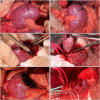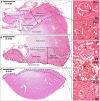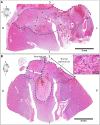Comparison of off-clamp microwave scissors-based sutureless partial nephrectomy versus on-clamp conventional partial nephrectomy in a canine model
- PMID: 37795145
- PMCID: PMC10546044
- DOI: 10.3389/fsurg.2023.1255929
Comparison of off-clamp microwave scissors-based sutureless partial nephrectomy versus on-clamp conventional partial nephrectomy in a canine model
Abstract
Objectives: To compare the usefulness and safety of off-clamp microwave scissors-based sutureless partial nephrectomy (MSPN) with on-clamp conventional partial nephrectomy (cPN) in dogs.
Methods: We performed off-clamp MSPN using microwave scissors (MWS) in six dogs, and on-clamp cPN in three dogs, in two-stage experiments. The bilateral kidney upper poles were resected via a midline incision under general anesthesia. After 14 days of follow-up, the lower pole resections were performed. The renal calyces exposed during renal resections were sealed and transected using MWS in off-clamp MSPN and were sutured in on-clamp cPN. In the off-clamp MSPN group, the generator's power output of MWS was set as either 50 W or 60 W for each kidney side. We compared the procedure time (PT), ischemic time (IT), blood loss (BL), and normal nephron loss (NNL) between the two techniques using the Mann-Whitney U-test.
Results: We successfully performed 24 off-clamp MSPNs and 12 on-clamp cPNs. The off-clamp MSPN was significantly superior to on-clamp cPN in avoiding renal ischemia (median IT, 0 min vs. 8.6 min, p < 0.001) and reducing PT (median PT, 5.8 min vs. 11.5 min, p < 0.001) and NNL (median NNL, 5.3 mm vs. 6.0 mm, p = 0.006) with comparable BL (median BL, 20.9 ml vs. 23.2 ml, p = 0.804). No bleeding and major urine leakage were noted during the reoperations.
Conclusions: Off-clamp MSPN outperforms on-clamp cPN in lowering the risks of postoperative renal function impairment in dogs.
Keywords: microwaves; off-clamp; partial nephrectomy; renal function; renal ischemia.
© 2023 Nguyen, Yamada, Naka, Mukaisho and Tani.
Conflict of interest statement
HN and TT belong to the joint research department of Shiga University of Medical Science and Nikkiso Co., Ltd. TT declares that he is the representative of Micron Shiga Inc. and the inventor of microwave scissors. Micron Shiga Inc. receives royalties provided by intellectual property of microwave scissors from Nikkiso Co., Ltd. The remaining authors declare that the research was conducted in the absence of any commercial or financial relationships that could be construed as a potential conflict of interest.
Figures




Similar articles
-
Microwave Scissors-Based Sutureless Laparoscopic Partial Nephrectomy Versus Conventional Open Partial Nephrectomy in a Porcine Model: Usefulness and Complications.Ann Surg Oncol. 2024 Sep;31(9):5804-5814. doi: 10.1245/s10434-024-15548-7. Epub 2024 Jun 8. Ann Surg Oncol. 2024. PMID: 38851638 Free PMC article.
-
Feasibility of Microwave Scissors-Based Off-Clamp Laparoscopic Partial Nephrectomy in a Porcine Model.Surg Innov. 2023 Aug;30(4):419-427. doi: 10.1177/15533506231165830. Epub 2023 Mar 24. Surg Innov. 2023. PMID: 36961743
-
Renal function is the same 6 months after robot-assisted partial nephrectomy regardless of clamp technique: analysis of outcomes for off-clamp, selective arterial clamp and main artery clamp techniques, with a minimum follow-up of 1 year.BJU Int. 2015 Jun;115(6):921-8. doi: 10.1111/bju.12975. Epub 2015 May 18. BJU Int. 2015. PMID: 25376793
-
Off-clamp partial nephrectomy has a positive impact on short- and long-term renal function: a systematic review and meta-analysis.BMC Nephrol. 2018 Jul 31;19(1):188. doi: 10.1186/s12882-018-0993-3. BMC Nephrol. 2018. PMID: 30064370 Free PMC article.
-
Impact of Renal Hilar Control on Outcomes of Robotic Partial Nephrectomy: Systematic Review and Cumulative Meta-analysis.Eur Urol Focus. 2019 Jul;5(4):619-635. doi: 10.1016/j.euf.2018.01.012. Epub 2018 Jul 14. Eur Urol Focus. 2019. PMID: 29422419
References
-
- Van Poppel H, Da Pozzo L, Albrecht W, Matveev V, Bono A, Borkowski A, et al. A prospective, randomised EORTC intergroup phase 3 study comparing the oncologic outcome of elective nephron-sparing surgery and radical nephrectomy for low-stage renal cell carcinoma. Eur Urol . (2011) 59:543–52. 10.1016/j.eururo.2010.12.013 - DOI - PubMed
LinkOut - more resources
Full Text Sources

